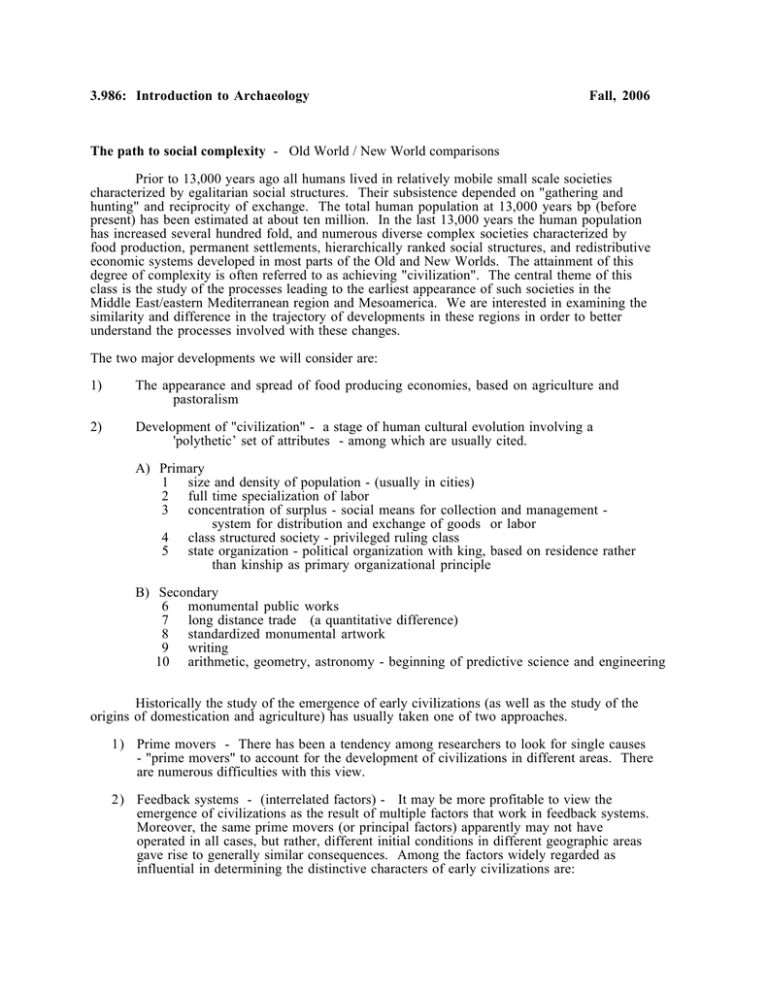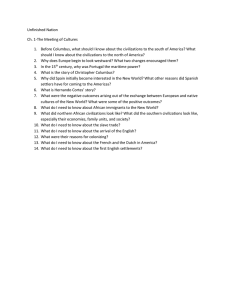Prior to 13,000 years ago all humans lived in relatively... characterized by egalitarian social structures. Their subsistence depended on... 3.986: Introduction to Archaeology
advertisement

3.986: Introduction to Archaeology Fall, 2006 The path to social complexity - Old World / New World comparisons Prior to 13,000 years ago all humans lived in relatively mobile small scale societies characterized by egalitarian social structures. Their subsistence depended on "gathering and hunting" and reciprocity of exchange. The total human population at 13,000 years bp (before present) has been estimated at about ten million. In the last 13,000 years the human population has increased several hundred fold, and numerous diverse complex societies characterized by food production, permanent settlements, hierarchically ranked social structures, and redistributive economic systems developed in most parts of the Old and New Worlds. The attainment of this degree of complexity is often referred to as achieving "civilization". The central theme of this class is the study of the processes leading to the earliest appearance of such societies in the Middle East/eastern Mediterranean region and Mesoamerica. We are interested in examining the similarity and difference in the trajectory of developments in these regions in order to better understand the processes involved with these changes. The two major developments we will consider are: 1) The appearance and spread of food producing economies, based on agriculture and pastoralism 2) Development of "civilization" - a stage of human cultural evolution involving a 'polythetic’ set of attributes - among which are usually cited. A) Primary 1 size and density of population - (usually in cities) 2 full time specialization of labor 3 concentration of surplus - social means for collection and management ­ system for distribution and exchange of goods or labor 4 class structured society - privileged ruling class 5 state organization - political organization with king, based on residence rather than kinship as primary organizational principle B) Secondary 6 monumental public works 7 long distance trade (a quantitative difference) 8 standardized monumental artwork 9 writing 10 arithmetic, geometry, astronomy - beginning of predictive science and engineering Historically the study of the emergence of early civilizations (as well as the study of the origins of domestication and agriculture) has usually taken one of two approaches. 1) Prime movers - There has been a tendency among researchers to look for single causes - "prime movers" to account for the development of civilizations in different areas. There are numerous difficulties with this view. 2) Feedback systems - (interrelated factors) - It may be more profitable to view the emergence of civilizations as the result of multiple factors that work in feedback systems. Moreover, the same prime movers (or principal factors) apparently may not have operated in all cases, but rather, different initial conditions in different geographic areas gave rise to generally similar consequences. Among the factors widely regarded as influential in determining the distinctive characters of early civilizations are: environment subsistence economy population technology integrative power of religion and art social organization irrigation warfare population growth trade social circumscription information flow Whether these factors are viewed as single prime movers or as interdependent factors in feedback systems, some of the sources of data and issues to be considered are as follows. 1) Environment - characteristics, features, resources and their role in these changes 2) Technological systems ­ tool making - stone working, metallurgy, pottery food procurement - food preparation, long term storage, hunting/gathering, agricultural, (irrigation) stock keeping building technology information (writing) 3) Subsistence (economics) diet availability of resources - technology and environment factors - (storage, irrigation) scheduling of resource use reciprocity versus redistributive systems craft - economic specialization - division of labor access to resources - trade/exchange, land and property ownership, warfare 4) Settlement patterns - demography - land use patterns demography - population size, density, growth rates, health degree of sedentary living size of community - house types, sizes, density of dwellings spacing in and between communities - hierarchical structuring of settlements 5) Social/Political structure ascribed and achieved statuses degree of stratification of society - egalitarian, ranked, stratified, state [acephalous bands, tribes, chiefdoms and states (kings)] role of kin structure or other corporate groups in governing 6) Religion and Ideology - sources of data ­ writing monuments artifacts burials





